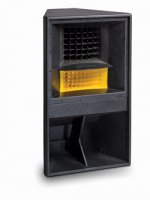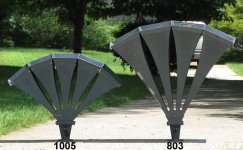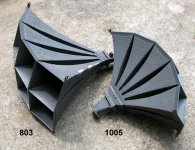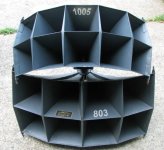I'm currently doing a study of the early cinema systems and how they were involved in the formation of the cinema "X" curve.
Multicells were easy to construct without major tooling. You could also form up common cells and make a variety of horns from them: 2 x 4 cells, 3 x 5 cells, etc. They tend to have broader HF dispersion than a radial but lower treble on axis because of it. Their polar curves aren't especially smooth.
I would be especially interested in any early measurements anyone has (beamwidth, d.i., etc.)
David Smith
History..
Stephens developed the "modern" multi-cell horn, spec.ed with a 17 deg. by 17 deg. exit, as part of the Shearer Horn project in the 30's. That specific pattern pretty much remained for most multi-cell horns manufactured, in that it allowed various manufacturers to tailor the "spread" (directivity) to a "degree" for audiences in different size theaters. Because it was part of a collaborative (multi-party) project, I don't think the design was ever patented (..along with others resulting from the Shearer Horn project). (..this was probably on purpose because of the abusive AT&T/Western Electric/ERPI contracts (leasing agreements) that were negotiated with theaters in the late 20's and early 30's - i.e. each principal involved (like Stephens) could use the designs for their own Co.s.) Stephens Manufacturing (True Sonic), Lansing Manufacturing (Iconic), Western Electric (Mirrophonic) - and then later All Technical (Altec), emerged as producers of the designs developed in the mid 30's Shearer Horn project.
As far as the effectiveness of the designs when compared to modern standards - most configurations had problems with uniform directivity. More importantly most had problems with uniform directivity *horizontally* - and depending on the horn and configuration (usually centered around 1 kHz) they would become increasingly directive. For use in home today that creates something of a presence "dip" in freq. response (averaged) - typically adding an enhanced sense of depth, that over time tends to sound artificial.
Sectoral horns (quasi multi-cells horizontally opposed) were created to address these issues. On the other hand Sectoral horns didn't go as low as the Multi-cells before loosing "loading" and directivity (..in an effort to maintain directivity much higher in freq.).
If you look at Mr. Hiraga's new listening room (that Panomaniac kindly supplied), you'll note that he is now using Sectorals in addition to the Multi-cells. Basically trying to get the both of best by (presumably) crossing over around 1 kHz from the Sectoral to the Multi-cell.
Last edited:
For use in home today that creates something of a presence "dip" in freq. response (averaged) - typically adding an enhanced sense of depth, that over time tends to sound artificial.
Scott - I wonder if this might be driver and personal taste dependent?
Certainly my horns don't have a presence dip, quite the opposite, actually. I handle the bump with the crossover.
As I tend to like a presence dip any almost any speaker, I build the crossovers that way anyhow. But I do agree that too much of a good thing can be bad. Like a lot of Internet radio I listen to. Seems EQ'd for small, desktop speakers - not for a flat system.
Scott - I wonder if this might be driver and personal taste dependent?
Certainly my horns don't have a presence dip, quite the opposite, actually. I handle the bump with the crossover.
As I tend to like a presence dip any almost any speaker, I build the crossovers that way anyhow. But I do agree that too much of a good thing can be bad. Like a lot of Internet radio I listen to. Seems EQ'd for small, desktop speakers - not for a flat system.
For the horn itself it isn't, the horn's pattern is the horn's pattern. Of course different cell groupings lead to different patterns. The std. 803B definitely has this problem. Just below 500 Hz it's about the same as it is at 2 kHz (up to I *think* the std. 8 kHz region), but within that freq. region (500-2kHz) it is considerably more directive (meaning a greater loss in pressure as you move (horizontally) to one side from the center.
On the other hand if you have this region elevated (either through driver or by eq.), then ON-AXIS you'll have a "bump" and OFF-AXIS you could have something "flat" (..and of course even further OFF-AXIS you'll have a "dip" again). In any event the *averaged* response is going to show some irregularities - and if you target flat ON-AXIS then it's going to be that "dip" I mentioned.
While you might never be able to get an *averaged* flat response, you might be able to get something much closer to flat for any single listening position - enough so that any dip isn't going to get much notice (..particularly if it's lower than 1.5 kHz).
The only thing that bothers me about an averaged "dip" is that it can start getting "generic"/"identifiable" in sound (..likable or not).
Anyway, I don't think the horizontal pattern is the sole reason why people often like Multi-cells (or perhaps even the major reason) - I think there are also other attributes (both positive and negative) to the design.
but within that freq. region (500-2kHz) it is considerably more directive (meaning a greater loss in pressure as you move (horizontally) to one side from the center.
Well my 803Bs are hot in that region. Centered on about 1300Hz. But I don't think that's just on axis. I could be wrong. I'll try to measure it.
Hi there,
although based on a completely different principle,
those remind me on the acoustic lens used by Harold Beveridge
in his famous electrostatic speakers. That lens is used
to control dispersion, it is not a horn of course.
Kind Regards
The Beveridge models were interesting. He used the various paths as a means of delaying the outter sections and creating a cylindrical wavefront. There are some large line array modules that do that now. Harold came by JBL when I was there in the early 80's, he was trying to sell the company. Nice looking stuff but each model sounded different.
If you are into that then you probably have read about the JBL acoustic lenses. I just found the Locanthi paper from 1954 (SMPTE Journal, vol. 63 September). Interesting reading and in the discussion, John Hilliard of Altec made some criticisms that don't make sense to me.
Finally, another multicell benefit from one of the early Altec papers: You can modify directivity by stuffing old socks in a cell or two!
David
1005 vs 803
Here are my Altec 1005 and 803 horns. 10 cells 500Hz cutoff vs 8 cells 300Hz cutoff.
They measure a lot alike with the same driver. The 803 does go a bit deeper, the 1005 goes no higher, but is flatter thru the midrange. Distortion is also almost the same, H2, H3, H4.
They do sound different, tho.
Here are my Altec 1005 and 803 horns. 10 cells 500Hz cutoff vs 8 cells 300Hz cutoff.
They measure a lot alike with the same driver. The 803 does go a bit deeper, the 1005 goes no higher, but is flatter thru the midrange. Distortion is also almost the same, H2, H3, H4.
They do sound different, tho.
Attachments
...
Finally, another multicell benefit from one of the early Altec papers: You can modify directivity by stuffing old socks in a cell or two!
...
David
Old socks is the mandatory stuffing ? 😀
Hey Cal _ thought you'd like my improvised 18 cell horn. 😀
Maybe I should stack 'em and play 'em. 288 on the 10 cell, 290 on the 8. Yikes!
Maybe I should stack 'em and play 'em. 288 on the 10 cell, 290 on the 8. Yikes!
Hello Pano and the rest of multicell fans!
Still enjoying those muticell horns or got over them?
Still enjoying those muticell horns or got over them?
Funny you should ask....
Just this week I revived my old 804 multicell horns that had been sitting idle. I bolted them up to BMS ND 4592 coax compression drivers and added an 18" woofer in a bass reflex box.
They are now doing very well as a P.A. for the 2400 seat amphitheater where I work. They are miles better than the QSC line-arrays that were hanging there before. The woofer plays more than an octave lower, and the multicell horns sound wonderful. Both horizontal and vertical coverage is much more even than with the line-arrays. There is a gain in midrange "bite" and definition, as well as increased fullness. That's a combo that's hard to beat.
Not a modern day Hi-Fi use, but good old fashioned P.A. use, as they were designed for.
Just this week I revived my old 804 multicell horns that had been sitting idle. I bolted them up to BMS ND 4592 coax compression drivers and added an 18" woofer in a bass reflex box.
They are now doing very well as a P.A. for the 2400 seat amphitheater where I work. They are miles better than the QSC line-arrays that were hanging there before. The woofer plays more than an octave lower, and the multicell horns sound wonderful. Both horizontal and vertical coverage is much more even than with the line-arrays. There is a gain in midrange "bite" and definition, as well as increased fullness. That's a combo that's hard to beat.
Not a modern day Hi-Fi use, but good old fashioned P.A. use, as they were designed for.
Why not use for home hi-fi?
I was interested in these for a while. My room is 17x26 ft.
I have this plan: Get 300hz, 15 multicell horns and use with JBL 2485 comp drivers.
My secret is (it's not a secret anymore) is to "disable" the central cell of the 15 cell horn and mount a tweeter into it, creating a coaxial version of the multicell. I'm guessing the crossover will be around 3khz. Tweeter will get delay via DSP.
Maybe Onken cabinet for the woofer section. So that's my plan but I have never actually heard a multicell.
Why not use for home hi-fi? What are the issues in sound quality? I would appreciate your thoughts because it's a significant project to undertake. I'd love to know the flaws of the multicell in a domestic setting.
Thanks!!
I was interested in these for a while. My room is 17x26 ft.
I have this plan: Get 300hz, 15 multicell horns and use with JBL 2485 comp drivers.
My secret is (it's not a secret anymore) is to "disable" the central cell of the 15 cell horn and mount a tweeter into it, creating a coaxial version of the multicell. I'm guessing the crossover will be around 3khz. Tweeter will get delay via DSP.
Maybe Onken cabinet for the woofer section. So that's my plan but I have never actually heard a multicell.
Why not use for home hi-fi? What are the issues in sound quality? I would appreciate your thoughts because it's a significant project to undertake. I'd love to know the flaws of the multicell in a domestic setting.
Thanks!!
Last edited:
I used Multicell for years in home Hi-Fi. Also as Hi-Fi P.A. I have no objections to either. You'll be pleasantly surprised.
They do sound best when you have some room to play, 17x26 is really at the lower limit of room size. And unless you have high ceilings in that room, you might be better off with 10 cells, not 15. Keep the reflections down.
Why would you want to limit the horn to 3 kHz? It's perfectly usable up to 7-8 kHz. Above that can be tricky, just depends on the driver.
They do sound best when you have some room to play, 17x26 is really at the lower limit of room size. And unless you have high ceilings in that room, you might be better off with 10 cells, not 15. Keep the reflections down.
Why would you want to limit the horn to 3 kHz? It's perfectly usable up to 7-8 kHz. Above that can be tricky, just depends on the driver.
Pano,
Good ( just too short a ) story on the legacy replacement besting the "latest + greatest" .
What QSC model line array ( + how many ) fell victim to 1930's SOTA ?
🙂
Good ( just too short a ) story on the legacy replacement besting the "latest + greatest" .
What QSC model line array ( + how many ) fell victim to 1930's SOTA ?
🙂
Pano,
some good thought there, I will have to consider between the 10 and 15 cell versions. I only mentioned a 3Khz crossover as a possibility. If I have them, I will know!
some good thought there, I will have to consider between the 10 and 15 cell versions. I only mentioned a 3Khz crossover as a possibility. If I have them, I will know!
Hey Earl! The QSC are these: WL2082-ILA Installation Line Array System – QSC
We had 6 per side, tri-amped. Total of 12 channels of amplification. The QSC use some rather nice B&C drivers, per box there are 2x8" woofers and 2X1" compression. Meaning that the line array woofers had about double the SD of my single 18" and who knows how much more magnet and 'phram for the tweeters than the sweet BMS drivers. So I was little nervous about having enough "umph". Need not have worried. The Altec 8 cell horns do just fine, and the 18" Dayton driver has plenty of low end and punch.
Caveat: It's not rock & roll. This is theater where the levels are actually sane. I'm over 60 performances in, so have a good idea of what the QSC sounded like. The multicell is several steps above. There is center focus, imaging, bass, depth & articulation now that was sorely missing before. The Altec hybrids are used to playback only prerecorded tracks - music and narration. It's now so much easier to hear the words, and I keep having "Oh, that's a trumpet" - or "that's a cello" moments listening to the tracks. Far more detail.
For the actor's mics I have a 9 box Renkus-Heinz array hung center that is decent sounding. All 780 pounds of it. Would love to replace it with two 15" woofers and an Altec 1004 horn.
And despite the claims of so many line array builders, the good old 1930-40 tech is much more evenly spread and consistent across the audience. It really does work like it's supposed to.
Forum member RA7 heard my home system when it had the 804 horns. Don't remember which drivers I had then, maybe Altec, maybe Radian. He might chime in about how they sounded for home Hi-Fi.
We had 6 per side, tri-amped. Total of 12 channels of amplification. The QSC use some rather nice B&C drivers, per box there are 2x8" woofers and 2X1" compression. Meaning that the line array woofers had about double the SD of my single 18" and who knows how much more magnet and 'phram for the tweeters than the sweet BMS drivers. So I was little nervous about having enough "umph". Need not have worried. The Altec 8 cell horns do just fine, and the 18" Dayton driver has plenty of low end and punch.
Caveat: It's not rock & roll. This is theater where the levels are actually sane. I'm over 60 performances in, so have a good idea of what the QSC sounded like. The multicell is several steps above. There is center focus, imaging, bass, depth & articulation now that was sorely missing before. The Altec hybrids are used to playback only prerecorded tracks - music and narration. It's now so much easier to hear the words, and I keep having "Oh, that's a trumpet" - or "that's a cello" moments listening to the tracks. Far more detail.
For the actor's mics I have a 9 box Renkus-Heinz array hung center that is decent sounding. All 780 pounds of it. Would love to replace it with two 15" woofers and an Altec 1004 horn.
And despite the claims of so many line array builders, the good old 1930-40 tech is much more evenly spread and consistent across the audience. It really does work like it's supposed to.
Forum member RA7 heard my home system when it had the 804 horns. Don't remember which drivers I had then, maybe Altec, maybe Radian. He might chime in about how they sounded for home Hi-Fi.
- Home
- Loudspeakers
- Multi-Way
- Multicell horns





